Design and Implementation of Miniature Multi-Mode 4 × 4 MIMO Antenna for WiFi 7 Applications
Abstract
1. Introduction
2. Configuration and Characteristics of Proposed MIMO
2.1. MIMO Antenna Structure
2.2. Working Principle
2.2.1. Analysis of the Wideband Characteristics
2.2.2. Analysis of Decoupling Characteristics
2.2.3. Parametric Analysis
3. Implementation and Performance of the MIMO Antenna Prototype
3.1. Measured Results of 4 × 4 MIMO Antenna Prototype
3.2. Diversity Performance of 4 × 4 MIMO Antenna Prototype
4. Conclusions
Author Contributions
Funding
Data Availability Statement
Conflicts of Interest
Abbreviations
| MIMO | Multiple-input multiple-output |
| CSRRs | Complementary split-ring resonators |
| ECC | Envelope correlation coefficient |
| DG | Diversity gain |
| SRR | Split-ring resonators |
| SIR | Step-impedance resonator |
| OTA | Over-the-air |
References
- Du, K.; Wang, Y.; Hu, Y. Design and Analysis on Decoupling Techniques for MIMO Wireless Systems in 5G Applications. Appl. Sci. 2022, 12, 3816. [Google Scholar] [CrossRef]
- Khan, R.; Al-Hadi, A.A.; Soh, P.J.; Kamarudin, M.R.; Ali, M.T. Owais User Influence on Mobile Terminal Antennas: A Review of Challenges and Potential Solution for 5G Antennas. IEEE Access 2018, 6, 77695–77715. [Google Scholar] [CrossRef]
- Citroni, R.; Di Paolo, F.; Livreri, P. Progress in THz Rectifier Technology: Research and Perspectives. Nanomaterials 2022, 12, 2479. [Google Scholar] [CrossRef] [PubMed]
- Mp, J.; Surekha, T.P.; Kumar Aj, S. Innovative Designs and Performance Evaluation of Super Wideband MIMO Antennas: A Survey. Nondestruct. Test. Eval. 2025, 1–32. [Google Scholar] [CrossRef]
- Holub, A.; Polivka, M. A Novel Microstrip Patch Antenna Miniaturization Technique: A Meanderly Folded Shorted-Patch Antenna. In Proceedings of the 14th Conference on Microwave Techniques, Prague, Czech Republic, 23–24 April 2008; IEEE: New York, NY, USA, 2008; pp. 1–4. [Google Scholar]
- Adhiyoga, Y.G.; Tjipto Rahardjo, E. Antenna Miniaturization Using Artificial Magneto-Dielectric Material with Split-Ring Slot. In Proceedings of the 2018 International Conference on Radar, Antenna, Microwave, Electronics, and Telecommunications (ICRAMET), Serpong, Indonesia, 1–2 November 2018; IEEE: New York, NY, USA, 2018; pp. 48–50. [Google Scholar]
- Li, M.; Luk, K.; Ge, L.; Zhang, K. Miniaturization of Magnetoelectric Dipole Antenna by Using Metamaterial Loading. IEEE Trans. Antennas Propagat. 2016, 64, 4914–4918. [Google Scholar] [CrossRef]
- Raj, T.; Mishra, R.; Kumar, P.; Kapoor, A. Advances in MIMO Antenna Design for 5G: A Comprehensive Review. Sensors 2023, 23, 6329. [Google Scholar] [CrossRef]
- Su, S.; Lee, C.; Chang, F. Printed MIMO-Antenna System Using Neutralization-Line Technique for Wireless USB-Dongle Applications. IEEE Trans. Antennas Propagat. 2012, 60, 456–463. [Google Scholar] [CrossRef]
- Wang, Y.; Du, Z. A Wideband Printed Dual-Antenna with Three Neutralization Lines for Mobile Terminals. IEEE Trans. Antennas Propagat. 2014, 62, 1495–1500. [Google Scholar] [CrossRef]
- Zhang, S.; Pedersen, G.F. Mutual Coupling Reduction for UWB MIMO Antennas with a Wideband Neutralization Line. Antennas Wirel. Propag. Lett. 2016, 15, 166–169. [Google Scholar] [CrossRef]
- Zhang, Y.; Deng, J.; Li, M.; Sun, D.; Guo, L. A MIMO Dielectric Resonator Antenna with Improved Isolation for 5G Mm-Wave Applications. Antennas Wirel. Propag. Lett. 2019, 18, 747–751. [Google Scholar] [CrossRef]
- Chen, S.-C.; Wang, Y.-S.; Chung, S.-J. A Decoupling Technique for Increasing the Port Isolation Between Two Strongly Coupled Antennas. IEEE Trans. Antennas Propagat. 2008, 56, 3650–3658. [Google Scholar] [CrossRef]
- Zhao, G.; Zhao, L.; Xi, M.; Guo, Y.; Huang, G.; Li, Y.; Wang, X.; Lin, W. A Three-Port Coupled Resonator Decoupling Network for Mutual Coupling Reduction of Three-Element Antenna Arrays. IEEE Trans. Microwave Theory Techn. 2024, 72, 6585–6600. [Google Scholar] [CrossRef]
- Li, R.L.; Chen, Z.Q.; Jiang, F.; Ye, L.H.; Li, J.F. Three-Port Ultrawideband MIMO Slot Antenna with High Isolation. Antennas Wirel. Propag. Lett. 2024, 23, 4388–4392. [Google Scholar] [CrossRef]
- Cui, L.; Guo, J.; Liu, Y.; Sim, C.-Y.-D. An 8-Element Dual-Band MIMO Antenna with Decoupling Stub for 5G Smartphone Applications. Antennas Wirel. Propag. Lett. 2019, 18, 2095–2099. [Google Scholar] [CrossRef]
- Tan, X.; Wang, W.; Wu, Y.; Liu, Y.; Kishk, A.A. Enhancing Isolation in Dual-Band Meander-Line Multiple Antenna by Employing Split EBG Structure. IEEE Trans. Antennas Propagat. 2019, 67, 2769–2774. [Google Scholar] [CrossRef]
- Alibakhshikenari, M.; Khalily, M.; Virdee, B.S.; See, C.H.; Abd-Alhameed, R.A.; Limiti, E. Mutual-Coupling Isolation Using Embedded Metamaterial EM Bandgap Decoupling Slab for Densely Packed Array Antennas. IEEE Access 2019, 7, 51827–51840. [Google Scholar] [CrossRef]
- Sun, L.; Li, Y.; Zhang, Z.; Feng, Z. Wideband 5G MIMO Antenna with Integrated Orthogonal-Mode Dual-Antenna Pairs for Metal-Rimmed Smartphones. IEEE Trans. Antennas Propagat. 2020, 68, 2494–2503. [Google Scholar] [CrossRef]
- Li, M.-Y.; Ban, Y.-L.; Xu, Z.-Q.; Guo, J.-H.; Yu, Z.-F. Tri-Polarized 12-Antenna MIMO Array for Future 5G Smartphone Applications. IEEE Access 2018, 6, 6160–6170. [Google Scholar] [CrossRef]
- Sun, L.; Feng, H.; Li, Y.; Zhang, Z. Compact 5G MIMO Mobile Phone Antennas with Tightly Arranged Orthogonal-Mode Pairs. IEEE Trans. Antennas Propagat. 2018, 66, 6364–6369. [Google Scholar] [CrossRef]
- Wong, K.; Chen, L. Small-Size LTE/WWAN Tablet Device Antenna with Two Hybrid Feeds. IEEE Trans. Antennas Propagat. 2014, 62, 2926–2934. [Google Scholar] [CrossRef]
- Manteuffel, D.; Martens, R. Compact Multimode Multielement Antenna for Indoor UWB Massive MIMO. IEEE Trans. Antennas Propagat. 2016, 64, 2689–2697. [Google Scholar] [CrossRef]
- Lu, W.; Zhu, L. Wideband Stub-Loaded Slotline Antennas Under Multi-Mode Resonance Operation. IEEE Trans. Antennas Propagat. 2015, 63, 818–823. [Google Scholar] [CrossRef]
- Wu, J.; Yin, Y.; Wang, Z.; Lian, R. Broadband Circularly Polarized Patch Antenna with Parasitic Strips. Antennas Wirel. Propag. Lett. 2015, 14, 559–562. [Google Scholar] [CrossRef]
- Wong, K.; Chou, L.; Su, C. Dual-Band Flat-Plate Antenna with a Shorted Parasitic Element for Laptop Applications. IEEE Trans. Antennas Propagat. 2005, 53, 539–544. [Google Scholar] [CrossRef]
- Li, B.; Leung, K.W. Strip-Fed Rectangular Dielectric Resonator Antennas with/without a Parasitic Patch. IEEE Trans. Antennas Propagat. 2005, 53, 2200–2207. [Google Scholar] [CrossRef]
- Tang, G.; Xiao, T.; Cao, L.; Cheng, R.; Liu, C.; Huang, L.; Xu, X. A Multi-Frequency Low-Coupling MIMO Antenna Based on Metasurface. Electronics 2024, 13, 2146. [Google Scholar] [CrossRef]
- Chung, M.-A.; Huang, S.-J.; Hsu, C.-C.; Lin, C.-W. A Compact and Multi-Coupled MIMO Antenna System Applicable to Various Electronic Devices for Sub6 GHz Design. IEEE Access 2025, 13, 60387–60402. [Google Scholar] [CrossRef]
- Wang, Z.; Dong, Y. Compact MIMO Antenna Using Stepped Impedance Resonatorbased Metasurface for 5G and WIFI Applications. Micro Opt. Tech. Lett. 2021, 63, 211–216. [Google Scholar] [CrossRef]
- Han, C.-Z.; Gong, G.; Wang, Y.; Guo, J.; Zhang, L. Wideband Terminal Antenna System Based on Babinet’s Principle for Sub-6 GHz and WiFi 6E/7 Applications. Micromachines 2024, 15, 705. [Google Scholar] [CrossRef]
- Hu, Y.; Wang, Y.; Zhang, L.; Li, M. Design of Miniaturized and Wideband Four-Port MIMO Antenna Pair for WiFi. Micromachines 2024, 15, 850. [Google Scholar] [CrossRef]
- Baena, J.D.; Bonache, J.; Martin, F.; Sillero, R.M.; Falcone, F.; Lopetegi, T.; Laso, M.A.G.; Garcia-Garcia, J.; Gil, I.; Portillo, M.F.; et al. Equivalent-Circuit Models for Split-Ring Resonators and Complementary Split-Ring Resonators Coupled to Planar Transmission Lines. IEEE Trans. Microwave Theory Tech. 2005, 53, 1451–1461. [Google Scholar] [CrossRef]


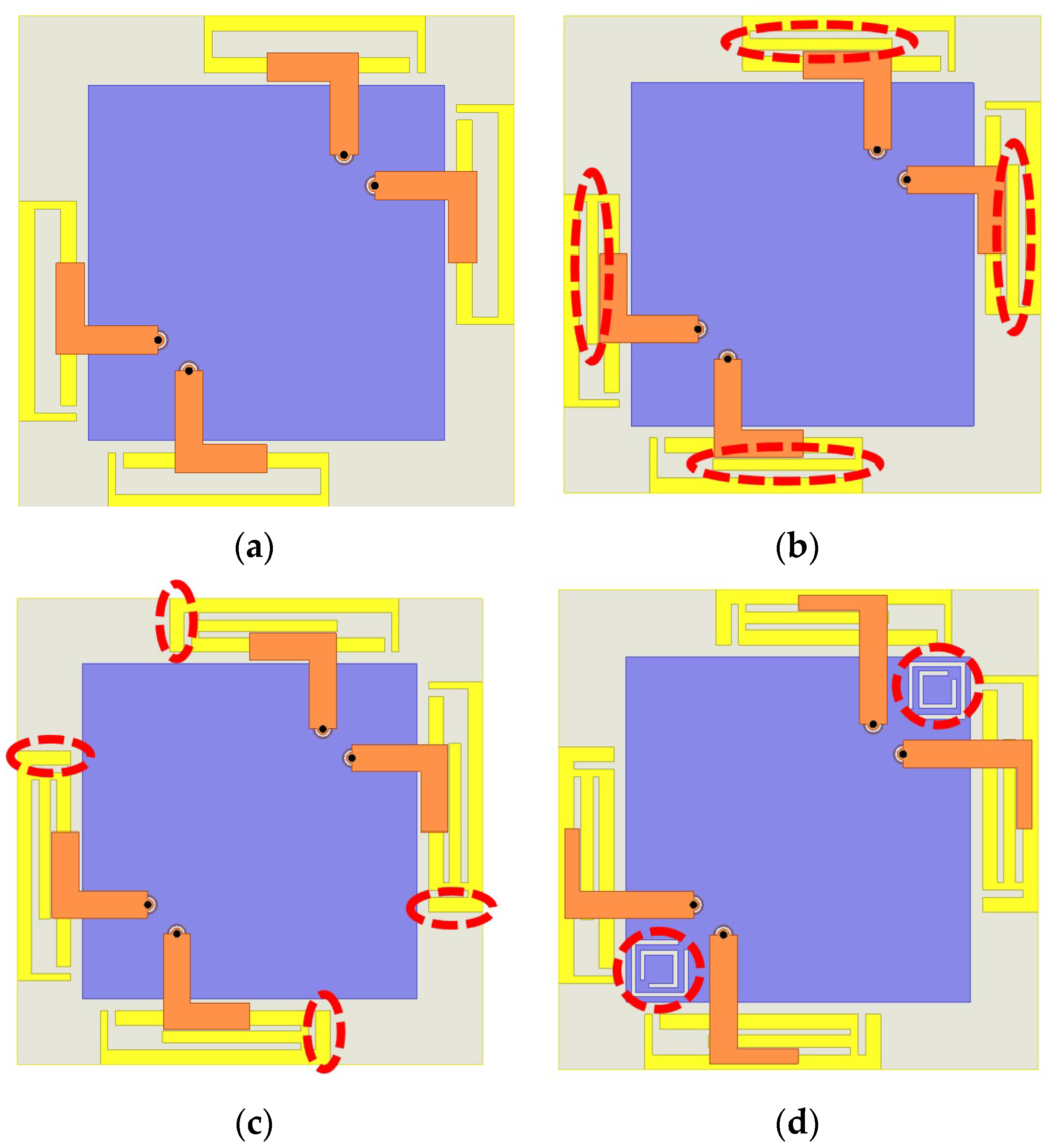
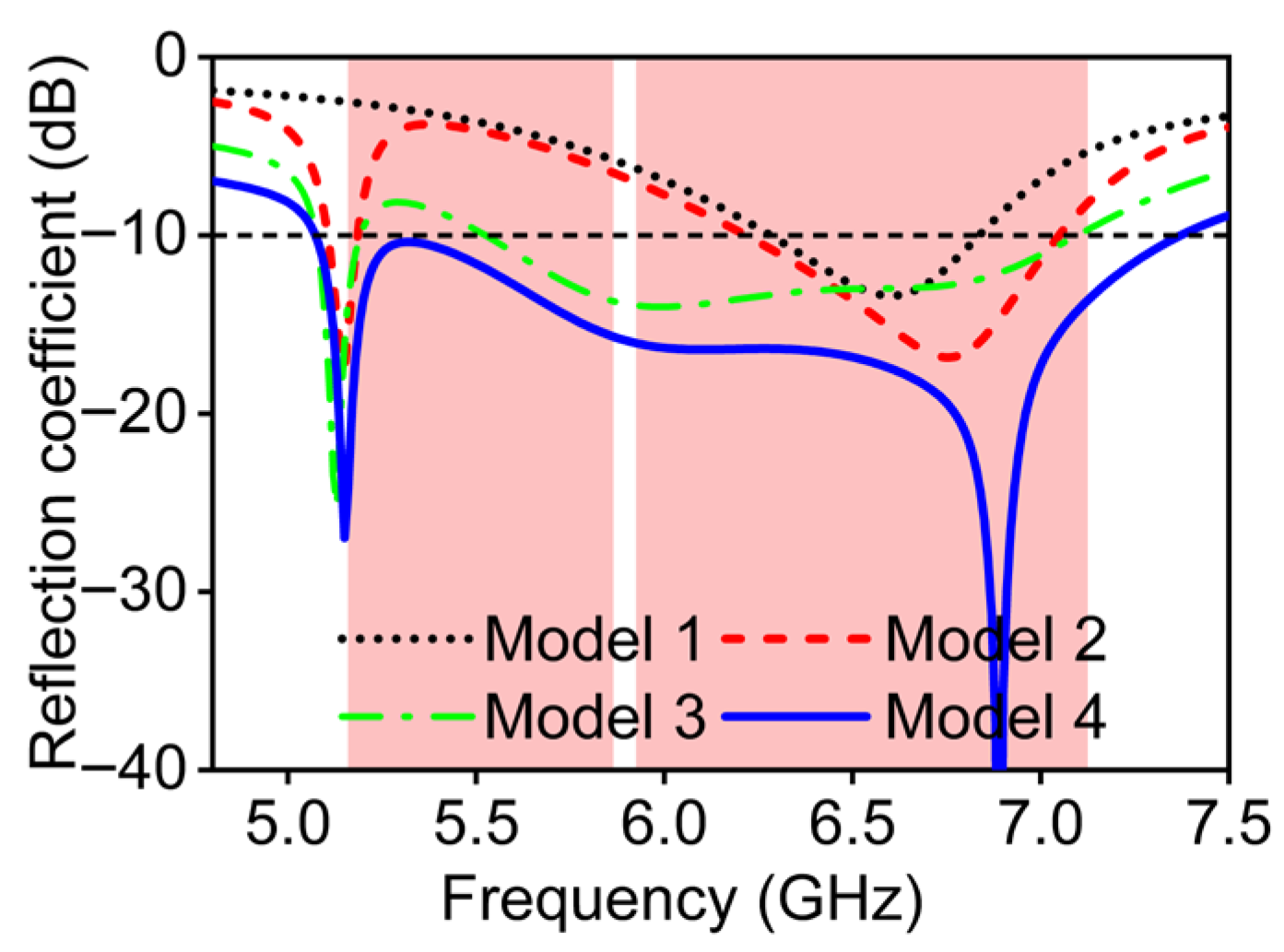
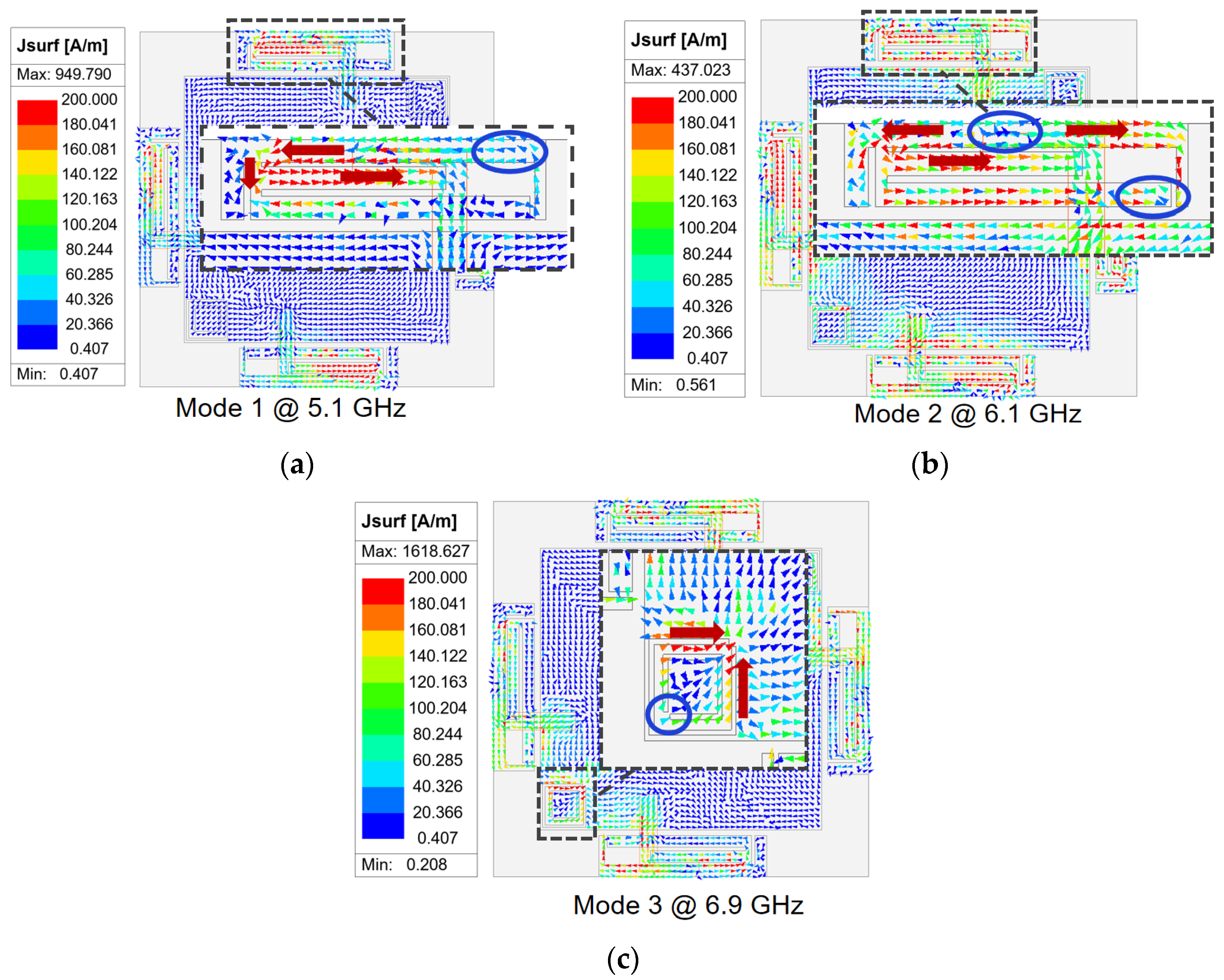
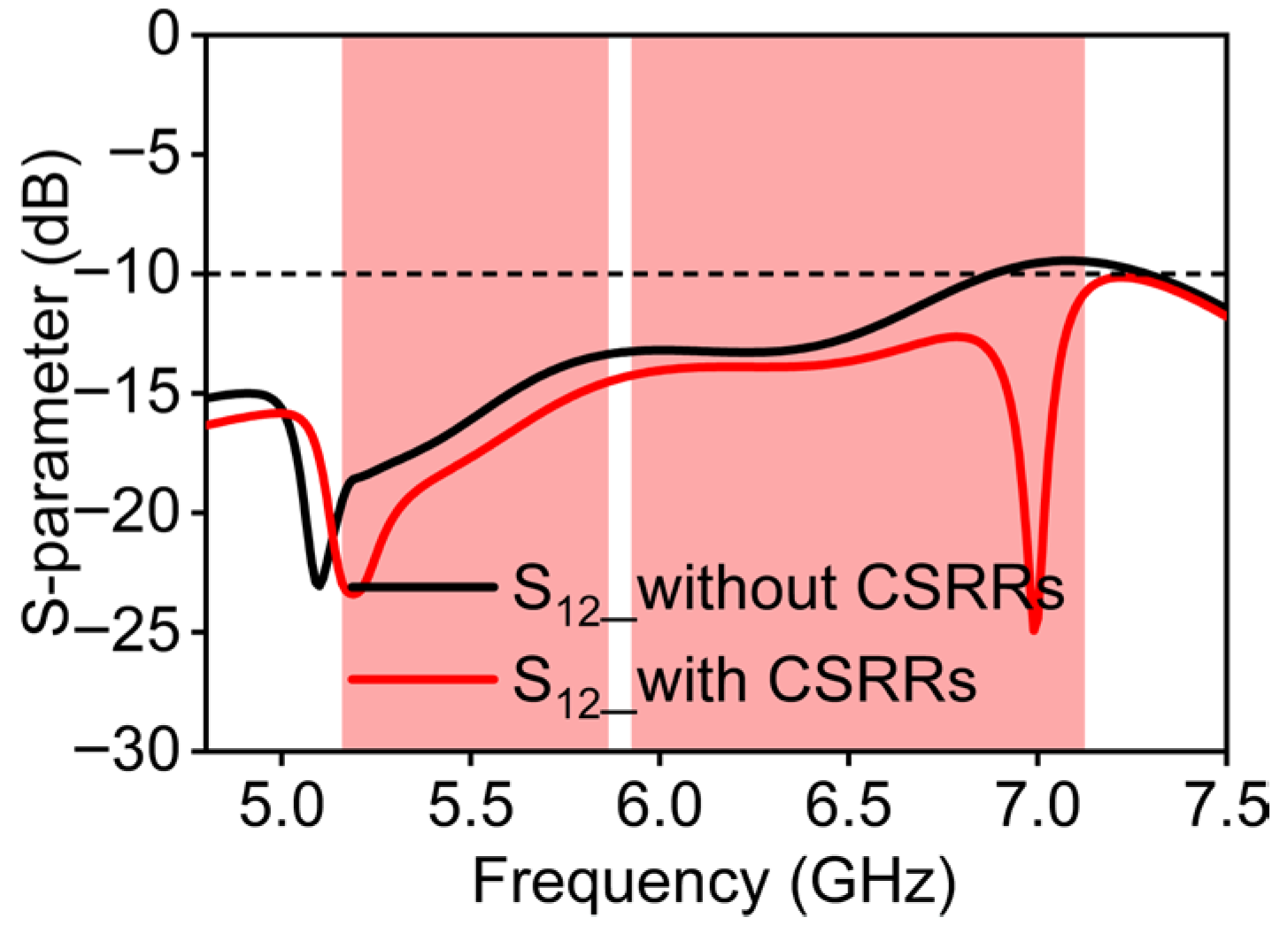
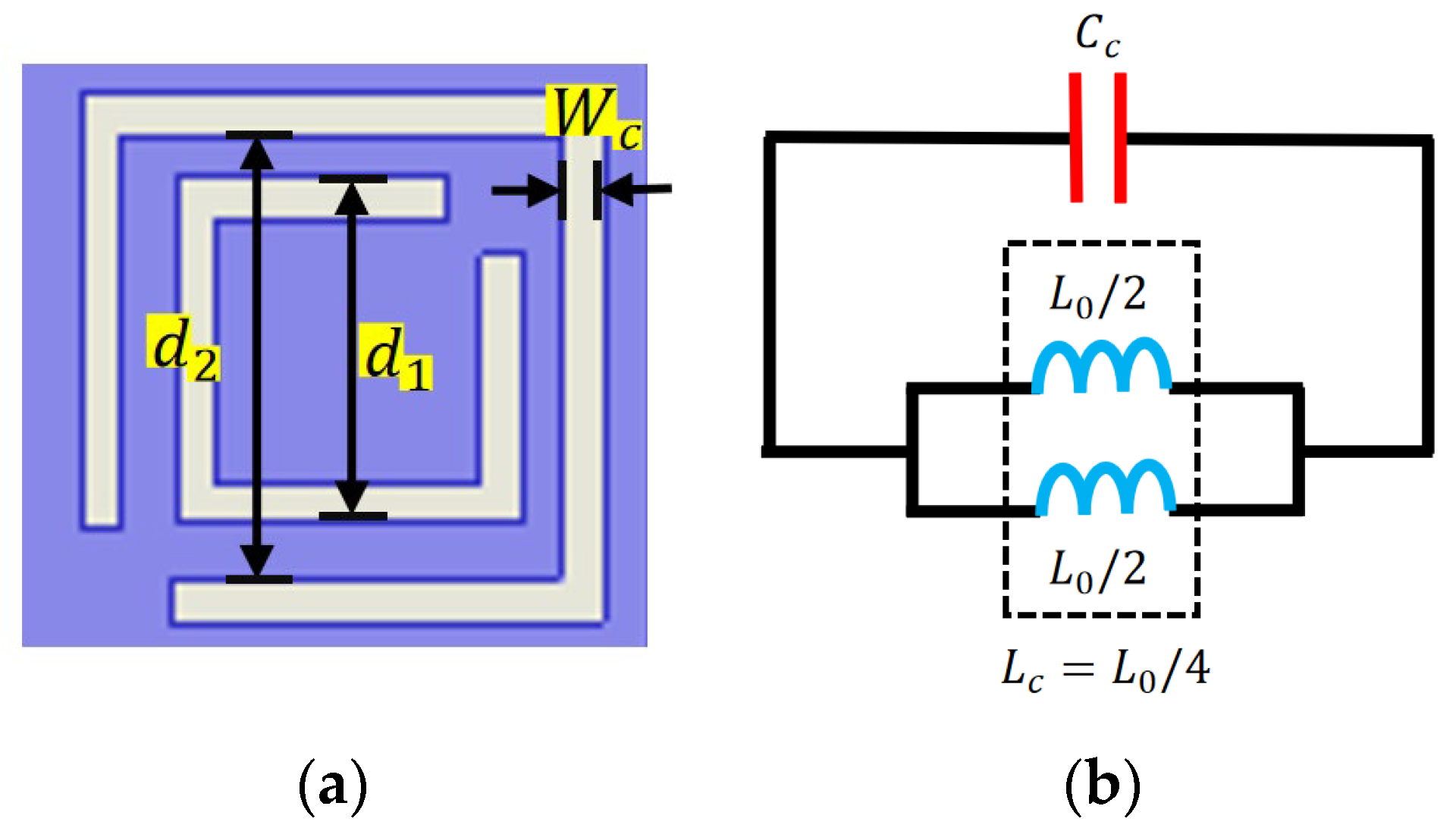

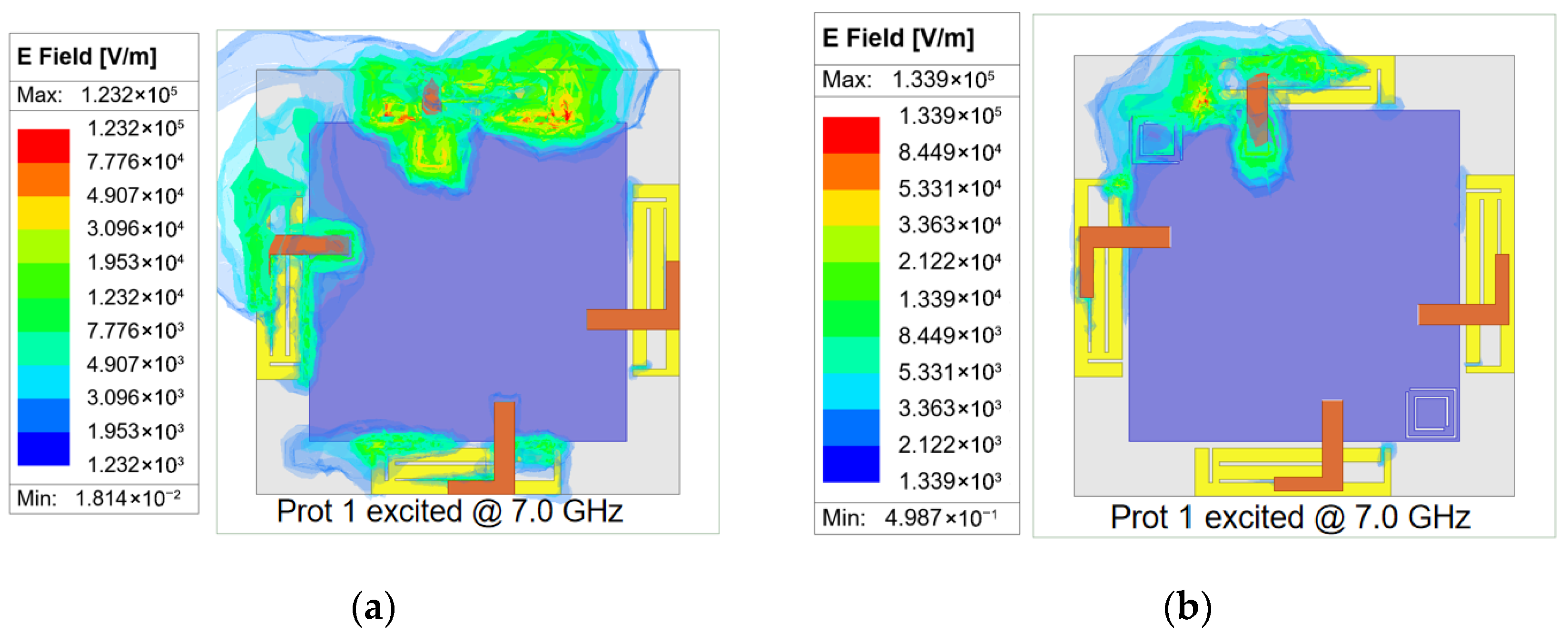
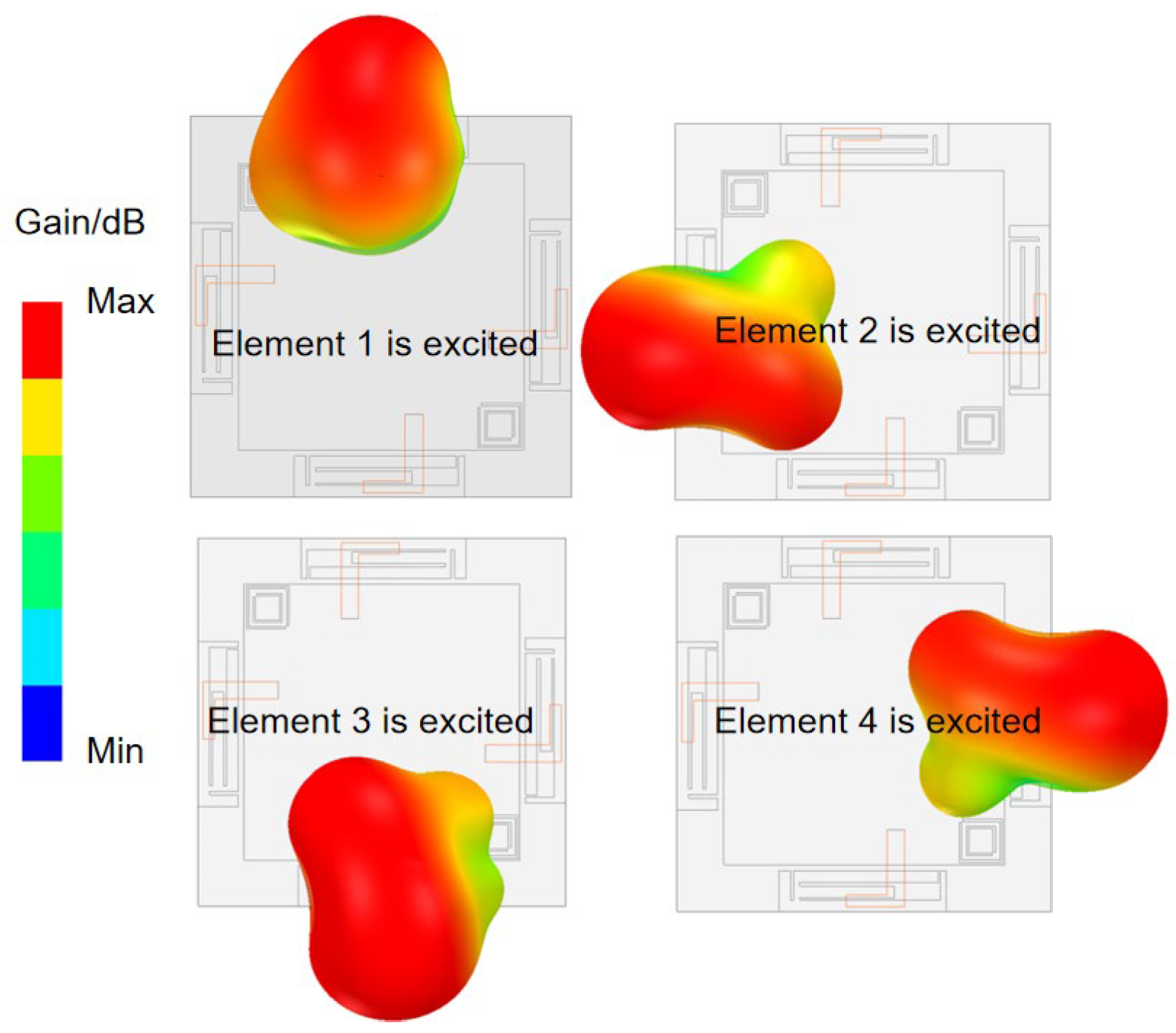

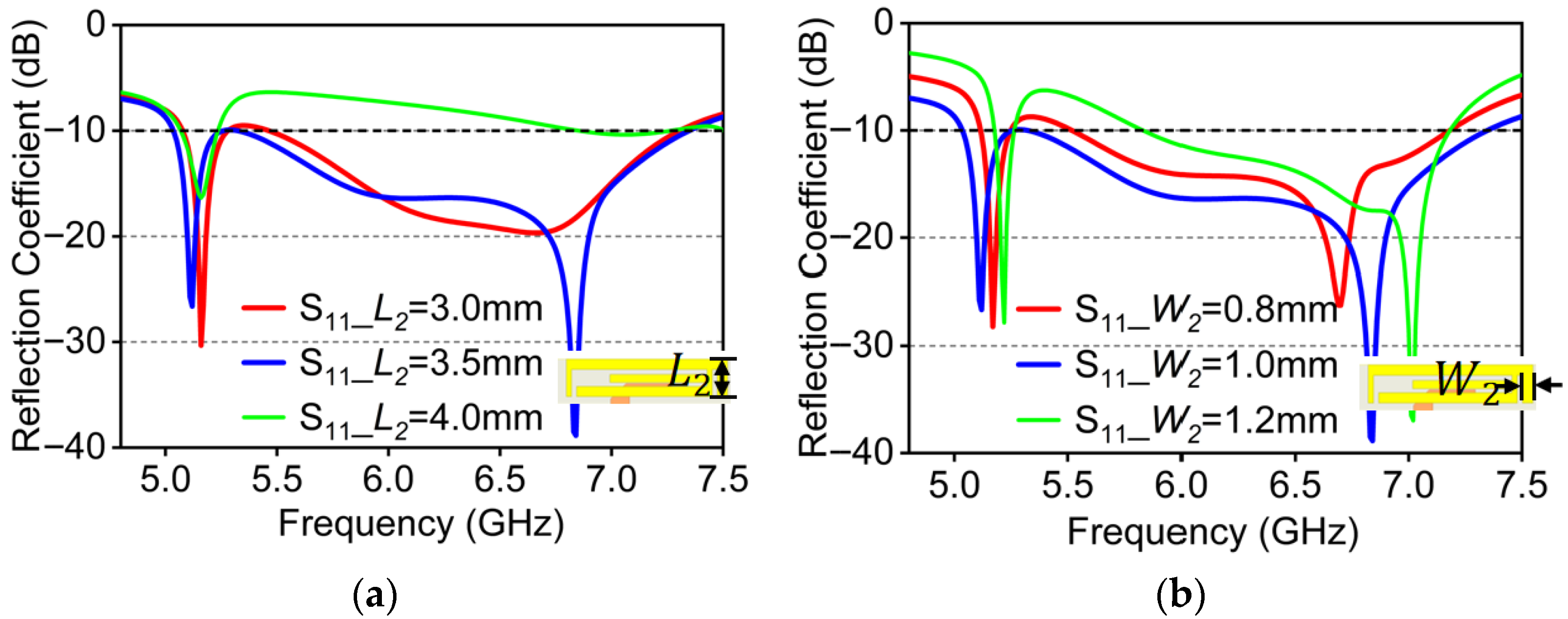

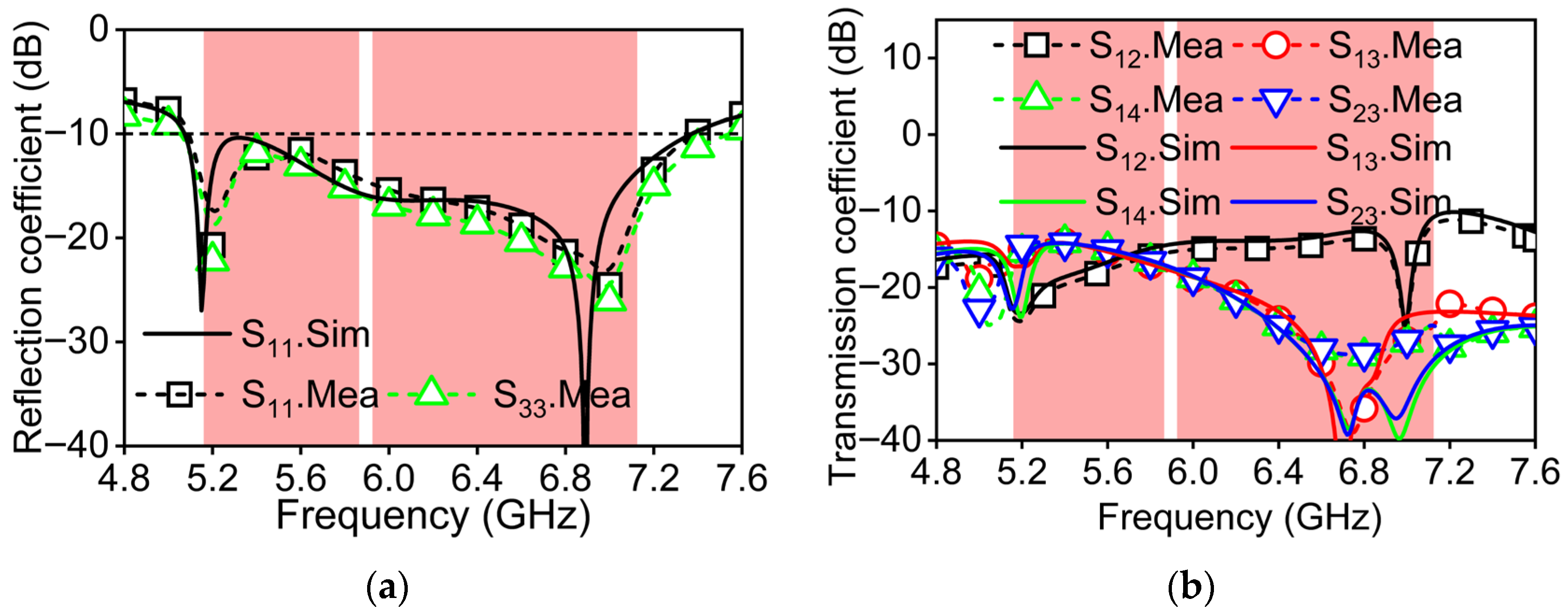

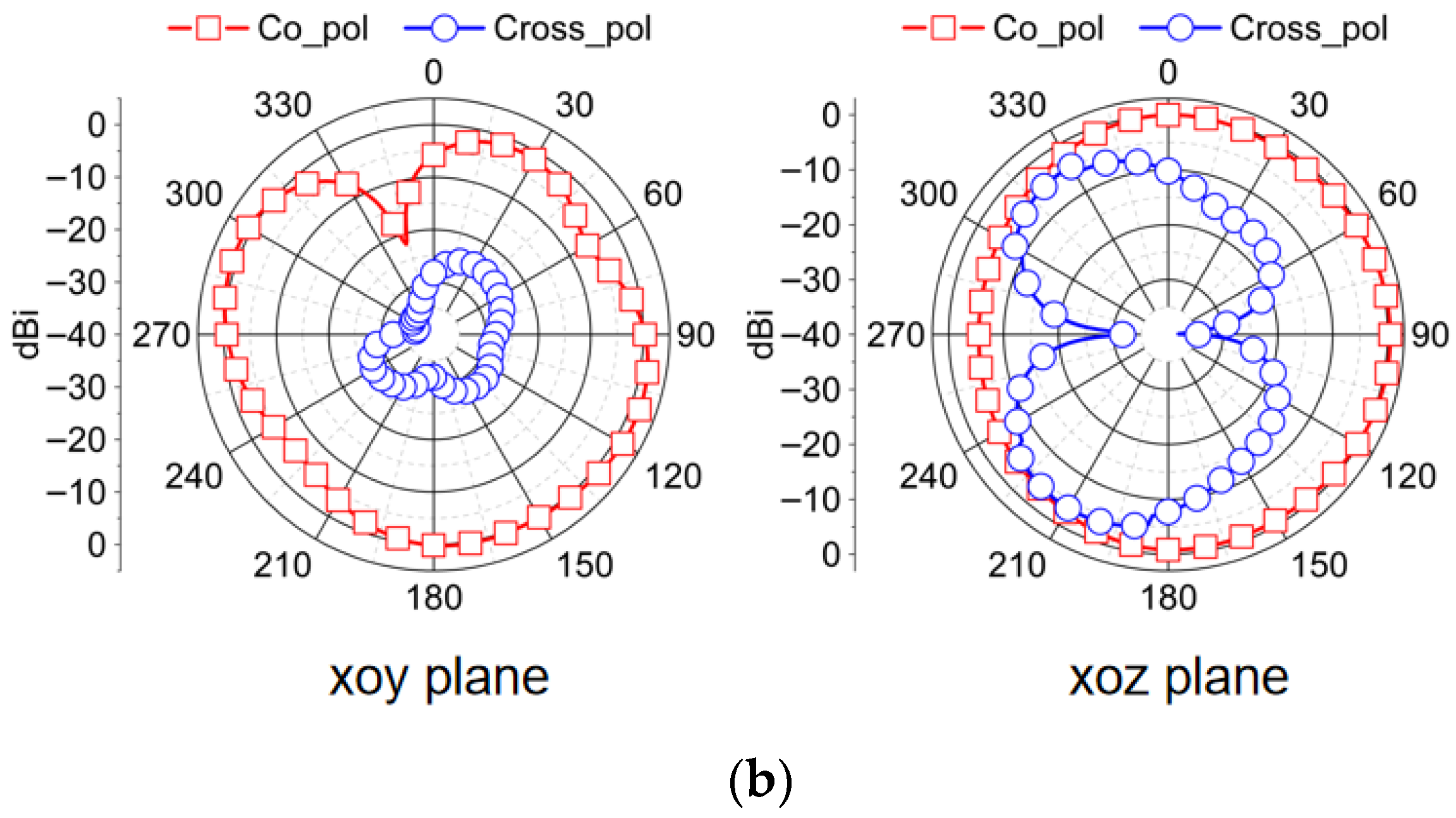

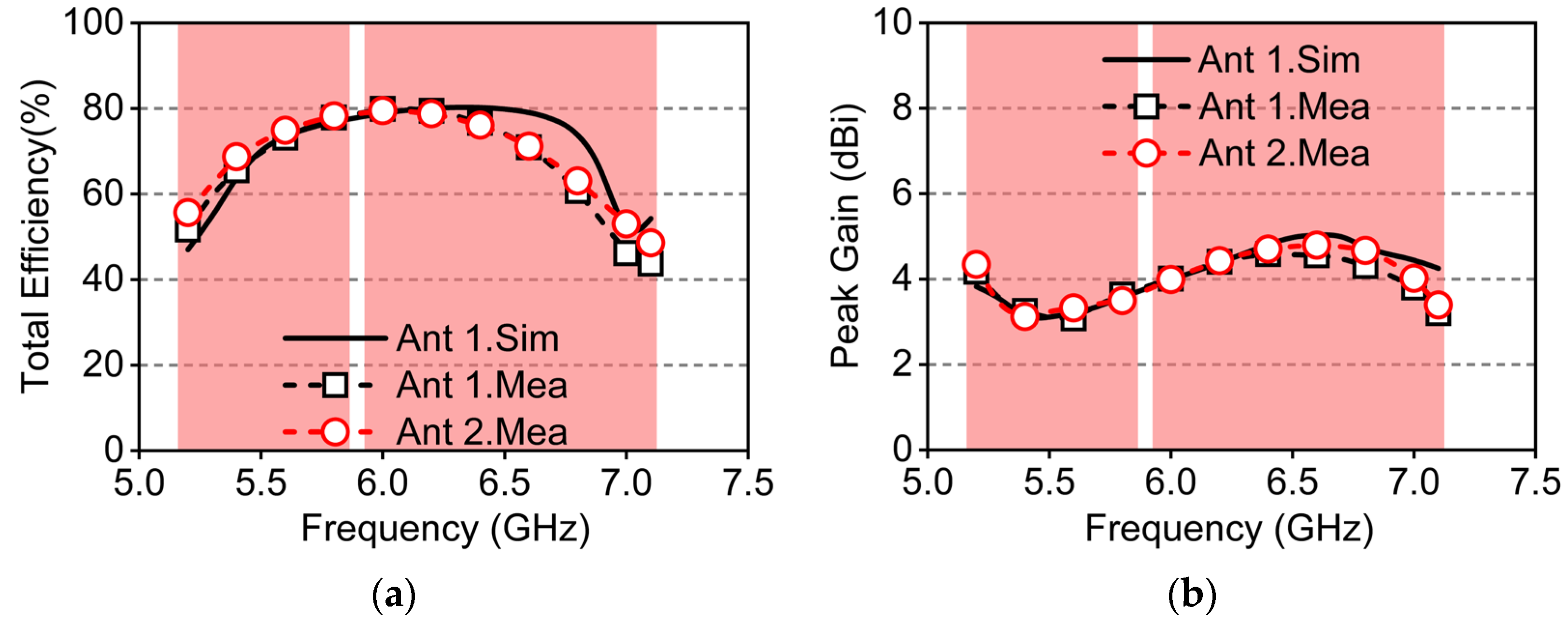

Disclaimer/Publisher’s Note: The statements, opinions and data contained in all publications are solely those of the individual author(s) and contributor(s) and not of MDPI and/or the editor(s). MDPI and/or the editor(s) disclaim responsibility for any injury to people or property resulting from any ideas, methods, instructions or products referred to in the content. |
© 2025 by the authors. Licensee MDPI, Basel, Switzerland. This article is an open access article distributed under the terms and conditions of the Creative Commons Attribution (CC BY) license (https://creativecommons.org/licenses/by/4.0/).
Share and Cite
Lin, W.; Du, K.; Jiang, X.; Wang, Y. Design and Implementation of Miniature Multi-Mode 4 × 4 MIMO Antenna for WiFi 7 Applications. Micromachines 2025, 16, 1331. https://doi.org/10.3390/mi16121331
Lin W, Du K, Jiang X, Wang Y. Design and Implementation of Miniature Multi-Mode 4 × 4 MIMO Antenna for WiFi 7 Applications. Micromachines. 2025; 16(12):1331. https://doi.org/10.3390/mi16121331
Chicago/Turabian StyleLin, Weizhen, Kaiwen Du, Xueyun Jiang, and Yongshun Wang. 2025. "Design and Implementation of Miniature Multi-Mode 4 × 4 MIMO Antenna for WiFi 7 Applications" Micromachines 16, no. 12: 1331. https://doi.org/10.3390/mi16121331
APA StyleLin, W., Du, K., Jiang, X., & Wang, Y. (2025). Design and Implementation of Miniature Multi-Mode 4 × 4 MIMO Antenna for WiFi 7 Applications. Micromachines, 16(12), 1331. https://doi.org/10.3390/mi16121331




